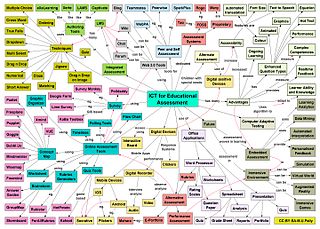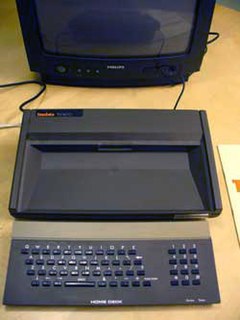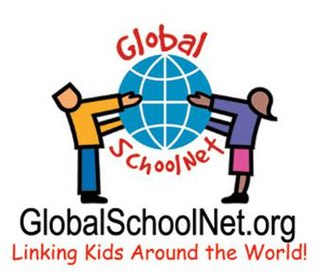Related Research Articles
Network society is the expression coined in 1991 related to the social, political, economic and cultural changes caused by the spread of networked, digital information and communications technologies. The intellectual origins of the idea can be traced back to the work of early social theorists such as Georg Simmel who analyzed the effect of modernization and industrial capitalism on complex patterns of affiliation, organization, production and experience.
Computer-mediated communication (CMC) is defined as any human communication that occurs through the use of two or more electronic devices. While the term has traditionally referred to those communications that occur via computer-mediated formats, it has also been applied to other forms of text-based interaction such as text messaging. Research on CMC focuses largely on the social effects of different computer-supported communication technologies. Many recent studies involve Internet-based social networking supported by social software.
The Delphi method or Delphi technique is a structured communication technique or method, originally developed as a systematic, interactive forecasting method which relies on a panel of experts. The technique can also be adapted for use in face-to-face meetings, and is then called mini-Delphi or Estimate-Talk-Estimate (ETE). Delphi has been widely used for business forecasting and has certain advantages over another structured forecasting approach, prediction markets.

The EFF Pioneer Award is an annual prize by the Electronic Frontier Foundation (EFF) for people who have made significant contributions to the empowerment of individuals in using computers. Until 1998 it was presented at a ceremony in Washington, D.C., United States. Thereafter it was presented at the Computers, Freedom, and Privacy conference. In 2007 it was presented at the O'Reilly Emerging Technology Conference.

Information and communications technology (ICT) is an extensional term for information technology (IT) that stresses the role of unified communications and the integration of telecommunications and computers, as well as necessary enterprise software, middleware, storage and audiovisual, that enable users to access, store, transmit, understand and manipulate information.
Computers and writing is a sub-field of college English studies about how computers and digital technologies affect literacy and the writing process. The range of inquiry in this field is broad including discussions on ethics when using computers in writing programs, how discourse can be produced through technologies, software development, and computer-aided literacy instruction. Some topics include hypertext theory, visual rhetoric, multimedia authoring, distance learning, digital rhetoric, usability studies, the patterns of online communities, how various media change reading and writing practices, textual conventions, and genres. Other topics examine social or critical issues in computer technology and literacy, such as the issues of the "digital divide", equitable access to computer-writing resources, and critical technological literacies.
Asynchronous learning is a general term used to describe forms of education, instruction, and learning that do not occur in the same place or at the same time. It uses resources that facilitate information sharing outside the constraints of time and place among a network of people. In many instances, well-constructed asynchronous learning is based on constructivist theory, a student-centered approach that emphasizes the importance of peer-to-peer interactions. This approach combines self-study with asynchronous interactions to promote learning, and it can be used to facilitate learning in traditional on-campus education, distance education, and continuing education. This combined network of learners and the electronic network in which they communicate are referred to as an asynchronous learning network.
Educational technology is the combined use of computer hardware, software, and educational theory and practice to facilitate learning. When referred to with its abbreviation, EdTech, it is often referring to the industry of companies that create educational technology.
A social networking service or SNS is an online platform which people use to build social networks or social relationships with other people who share similar personal or career content, interests, activities, backgrounds or real-life connections.
Networked learning is a process of developing and maintaining connections with people and information, and communicating in such a way so as to support one another's learning. The central term in this definition is connections. It adopts a relational stance in which learning takes place both in relation to others and in relation to learning resources. In design and practice, networked learning is intended to facilitate evolving sets of connections between learners and their interpersonal communities, knowledge contexts, and digital technologies.

Paul Levinson is an American author, singer-songwriter, and professor of communications and media studies at Fordham University in New York City. His novels, short fiction, and non-fiction works have been translated into sixteen languages.
Linda Marie Harasim, a "leading teacher, scholar and speaker on the theories and practices of online education, contributing knowledge, technologies, and practices to the field of technology-enabled learning," is a pioneer leading theorist of online education. She is a professor emerita in the School of Communication at Simon Fraser University (SFU) in Vancouver, British Columbia, Canada. Her six books and hundreds of articles about Computer-supported collaborative learning have been acknowledged as seminal works in the field.
Rob Kling was a North American professor of Information Systems and Information science at the School of Library and Information Science (SLIS) and Adjunct Professor of Computer Science, Indiana University, United States. He directed the interdisciplinary Center for Social Informatics (CSI), at Indiana University. He is considered to have been a key founder of social analyses of computing and a leading expert on the study of social informatics.

A virtual learning environment (VLE) is a system that creates an environment designed to facilitate teachers' management of educational courses for their students, especially a system using computer hardware and software, which involves distance learning. In North America, a virtual learning environment is often referred to as a "learning management system" (LMS).
Murray Turoff is a retired Distinguished Professor at New Jersey Institute of Technology (NJIT) who was a key founding father of computer-mediated communication.
Starr Roxanne Hiltz is a retired Distinguished Professor of Information Science/Information Systems at New Jersey Institute of Technology (NJIT). She, along with Murray Turoff, are the authors of The Network Nation, a book that is described as "the seminal book that helped define the electronic frontier".
Real-time Delphi (RTD) is an advanced form of the Delphi method. The advanced method “is a consultative process that uses computer technology” to increase efficiency of the Delphi process.

Global SchoolNet (GSN) is a nonprofit 501(c)3 international educational organization that serves as a clearinghouse for collaborative educational projects, many that are based on the Constructivist Learning model. The organization coordinates projects and competitions focused on humanitarian issues, diplomacy, leadership, innovative teaching, entrepreneurship, STEM, and other academics for schools and youth organizations internationally. About 150,000 educators from 194 countries have registered as members of Global SchoolNet, and about 5.5 million students from 109 countries have participated in GSN projects as of 2020. Global SchoolNet is known for two international competitions, the International CyberFair for students in grades kindergarten through high school, and the U.S. State Department-sponsored Doors to Diplomacy for ages 12 through 19. Global SchoolNet was established in 1984 as Free Educational Mail (FrEdMail) in San Diego, California, where its headquarters still exists.

Information technology (IT) is the use of computers to create, process, store, retrieve, and exchange all kinds of electronic data and information. IT is typically used within the context of business operations as opposed to personal or entertainment technologies. IT is considered to be a subset of information and communications technology (ICT). An information technology system is generally an information system, a communications system, or, more specifically speaking, a computer system – including all hardware, software, and peripheral equipment – operated by a limited group of IT users.
The Electronic Information Exchange System was an early online conferencing bulletin board system that allowed real-time and asynchronous communication. The system was used to deliver courses, conduct conferencing sessions, and facilitate research. Funded by the National Science Foundation and developed from 1974-1978 at the New Jersey Institute of Technology (NJIT) by Murray Turoff based on his earlier EMISARI done at the now-defunct Office of Emergency Preparedness, EIES was intended to facilitate group communications that would allow groups to make decisions based on their collective intelligence rather than the lowest common denominator. Initially conceived as an experiment in computer mediated communication, EIES remained in use for decades because its users "just wouldn't let go" of it, eventually adapting it for legislative, medical and even spiritual uses.
References
- ↑ Linda Marie Harasim; Starr Roxanne Hiltz; Lucio Teles; Murray Turoff (1995). Learning Networks . MIT Press. pp. 103–104. ISBN 0-262-08236-5.
- ↑ Withrow, Frank (June 1, 1997). "Technology in Education and the Next Twenty-Five Years -- THE Journal". T.H.E. Journal. Retrieved 21 January 2014.
- 1 2 Vicky Phillips (September 1996). "geteducated.com". Internet World. Archived from the original on 2008-07-05. Retrieved 2008-08-25.
- 1 2 3 Ray Percival (1995-11-28). "Carry on learning". New Scientist. Retrieved 2008-08-25.
- ↑ Starr Roxanne Hiltz (1994). The Virtual Classroom: Learning Without Limits Via Computer Networks. Ablex. pp. 57–58.
- 1 2 Paul Eng (1994-10-17). "A sheepskin from Online U." Business Week. Retrieved 2008-08-24.
- 1 2 Michael Freitag (1989-04-02). "LIFE STYLE:As Computer Bulletin Boards Grow, If It's Out There, It's Posted Here". The New York Times (paid access). Retrieved 2008-08-25.
- ↑ Softserv 4.03 (1991-06-05). "Catalog of paperless books available from Softserv". Softserv Catalog. Archived from the original on July 2, 2008. Retrieved 2008-08-25.
- 1 2 Gail S. Thomas (1988-02-01). "Connected Education, Inc". Netweaver. Electronic Networking Association. Archived from the original on 2008-08-27. Retrieved 2008-08-25.
- ↑ Apple A2 Pro Roundtable (1993-03-01). "Digital Publishing News". GEnie Lamp A2Pro ~ A T/TalkNET OnLine Publication ~ Vol.1, Issue 02. Retrieved 8 October 2010.